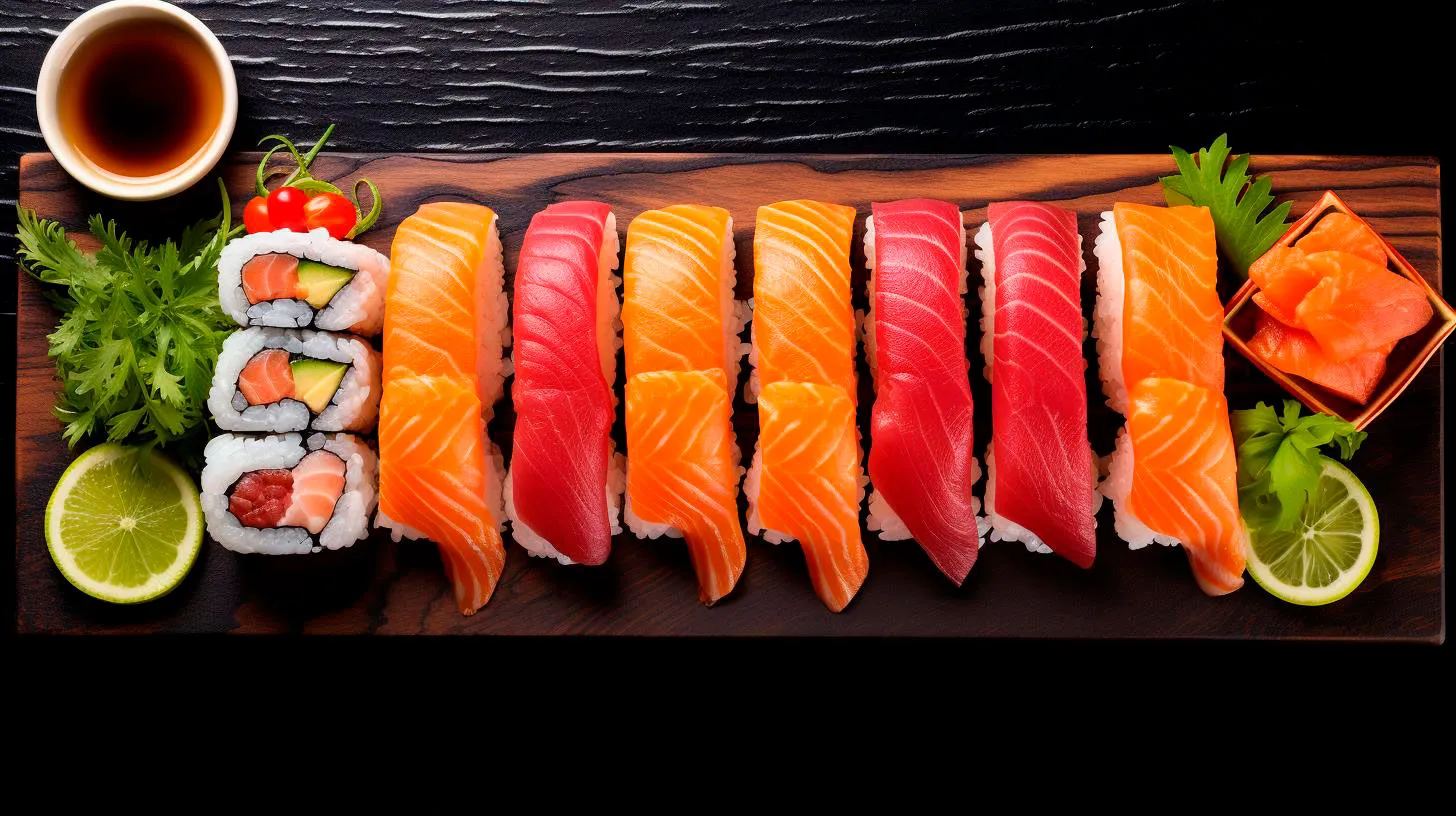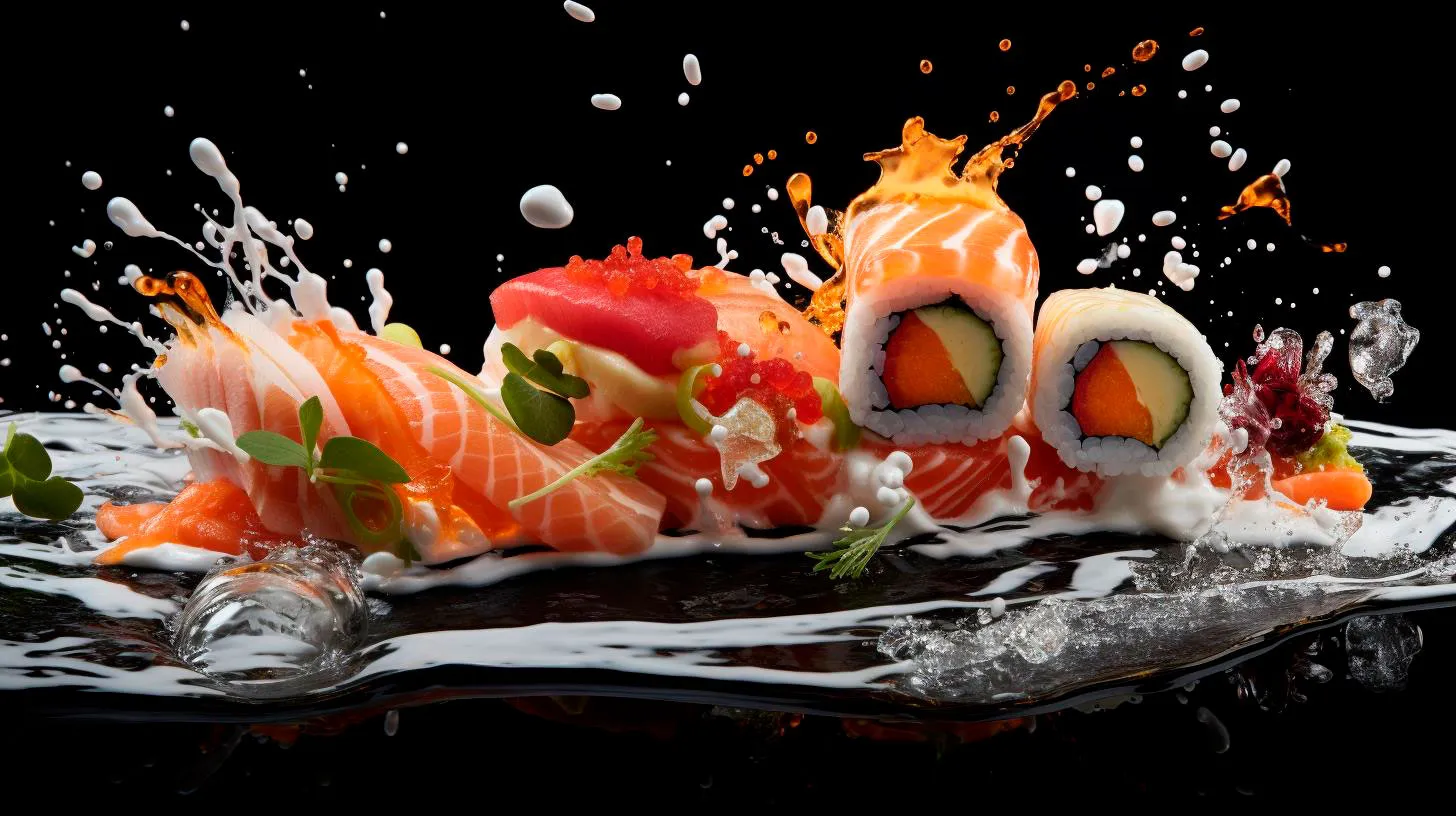Avoiding Sushi Allergies: Expert Tips for Safe Dining
Sushi often contains raw fish, shellfish, and other potential allergens that can trigger severe reactions. In this article, we will guide you through expert tips to ensure safe dining and to help you avoid sushi allergies.
Understanding Sushi Allergies
Before we dive into the tips, let’s first understand what sushi allergies are and how they can affect individuals. Allergic reactions to sushi typically occur due to two primary causes:
- Raw Fish Allergy: Some individuals develop allergies to specific types of fish, such as tuna, salmon, or mackerel. These allergies can range from mild to severe, with symptoms including hives, itching, vomiting, and even anaphylaxis.
- Shellfish Allergy: Shellfish allergies are common and can cause a wide range of symptoms, including itching, swelling, difficulty breathing, and in severe cases, anaphylaxis. Sushi often includes shellfish such as shrimp, crab, or scallops, making it risky for those with shellfish allergies.
Now that we have a basic understanding of sushi allergies, let’s explore some expert tips to help you enjoy sushi without any health concerns.
Expert Tips for Safe Sushi Dining
1. Know your Allergies and Communicate with the Staff
If you have a known fish or shellfish allergy, it’s crucial to inform the sushi restaurant staff about your condition. This step is essential to ensure they take necessary precautions while preparing your sushi. Communication is key, and a reputable sushi chef will be able to guide you through the menu, suggesting safe choices or providing alternative options.
2. Opt for Cooked Sushi Rolls
One of the simplest ways to mitigate the risk of allergies is to choose cooked sushi rolls, also known as maki. These rolls are made with cooked fish, vegetables, or other fillings, eliminating the risk of raw fish allergies. Popular cooked sushi rolls include California Roll, Philadelphia Roll, and Tempura Roll.
3. Avoid Cross-Contamination
Cross-contamination is a significant concern when it comes to sushi allergies. Even if you choose cooked sushi, there is a risk of cross-contamination if the same utensils or surfaces are used for both raw and cooked ingredients. It’s vital to ask the sushi chef to use separate utensils and surfaces to avoid any allergen contamination.
4. Be Aware of Hidden Ingredients
Some sushi rolls or toppings may contain hidden ingredients that could trigger allergies. For example, certain sauces, like eel sauce or spicy mayo, often contain allergens like fish or shellfish. Make sure to inquire about the ingredients used in each dish, including the sauces and toppings, to avoid any unexpected allergic reactions.
5. Bring Your Own Soy Sauce and Wasabi
Most sushi restaurants provide soy sauce and wasabi, but they may not be allergy-safe due to potential cross-contamination. To be extra cautious, it’s recommended to carry your own packets of soy sauce and wasabi, which are readily available at many grocery stores. This way, you can enjoy your sushi without worrying about hidden allergens.
Key Takeaways
When it comes to sushi dining, individuals with fish or shellfish allergies need to take extra precautions. Here are the key takeaways to remember:
- Inform the restaurant staff about your allergies and seek guidance on suitable menu choices.
- Choose cooked sushi rolls to eliminate the risk of raw fish allergies.
- Ensure there is no cross-contamination between raw and cooked ingredients.
- Ask about hidden ingredients, such as sauces or toppings, to avoid allergic reactions.
- Carry your own soy sauce and wasabi to minimize the risk of allergen contamination.
By following these expert tips, you can enjoy a safe and delicious sushi dining experience without any worries about allergies. Remember, it’s crucial to prioritize your health and make informed choices when it comes to food allergies.
Mastering the Art of Sushi: A Guide to Allergy-Free Options
However, for individuals with food allergies or dietary restrictions, enjoying this Japanese delicacy can often be a challenge.
In recent years, the awareness and prevalence of food allergies have been on the rise. According to the Food Allergy Research and Education (FARE), an estimated 32 million Americans have food allergies. If you are one of them or simply looking for allergy-free options, this guide will help you navigate the sushi world while keeping your taste buds satisfied and your health intact.
Common Allergens in Sushi
Sushi is traditionally made using a few basic ingredients, including rice, seaweed, fish, and vegetables. However, some common allergens that may be present in sushi include:
- Seafood: Fish and shellfish are staple ingredients in many sushi rolls, making them potential allergens for those who are allergic to seafood.
- Soy: Soy sauce, a popular condiment for sushi, contains soybeans and can be problematic for individuals with soy allergies.
- Gluten: Tempura, a popular ingredient in sushi, is often made with wheat flour, making it unsuitable for those with gluten sensitivities or celiac disease.
- Sesame: Some sushi rolls are garnished with sesame seeds or contain sesame oil, which can cause allergic reactions in individuals with sesame allergies.
Allergy-Friendly Sushi Options
Thankfully, sushi chefs and restaurants are becoming more attentive to customer needs and providing allergy-friendly options. Here are some allergy-free alternatives and suggestions to enjoy sushi without compromising your health:
1. Vegetarian Sushi
Vegetarian sushi rolls are an excellent choice for individuals with seafood allergies or those who prefer a plant-based diet. These rolls are usually filled with a combination of fresh vegetables, avocado, and tofu, providing a burst of flavors and textures. Some popular vegetarian rolls include:
- Avocado Roll
- Cucumber Roll
- Asparagus Roll
- Sweet Potato Roll
2. Sashimi
If you’re avoiding rice or gluten, sashimi is a fantastic option. Sashimi consists of thinly sliced raw fish or seafood without rice or other fillings. It is typically served with soy sauce and wasabi, ensuring a flavorful and allergy-friendly dining experience.
3. Tamari Sauce and Gluten-Free Soy Sauce
For those with soy allergies or gluten sensitivities, tamari sauce and gluten-free soy sauce can be a suitable substitute for regular soy sauce. These alternatives are made without wheat and provide a similar taste experience.
4. Customized Orders
When dining at a sushi restaurant, don’t hesitate to communicate your allergies or dietary restrictions to the chef or server. Many restaurants are accommodating and can alter their dishes to suit your needs. Opting for customized rolls, excluding allergens, or using alternative ingredients can ensure a safe and enjoyable sushi experience.
Key Takeaways
Sushi is a culinary art form that offers a variety of options for individuals with food allergies or dietary restrictions. Here are the key takeaways to keep in mind when exploring allergy-free sushi:
- Common allergens in sushi include seafood, soy, gluten, and sesame.
- Vegetarian sushi rolls are a great option for seafood allergies and vegetarians.
- Sashimi is a rice-free and gluten-free alternative for those avoiding specific allergens.
- Tamari sauce and gluten-free soy sauce are suitable substitutes for regular soy sauce.
- Customizing your sushi order can ensure a safe and enjoyable dining experience.
As food allergies become more prevalent, it’s crucial for sushi restaurants to adapt and offer allergy-friendly options. By mastering the art of sushi while considering allergy restrictions, sushi lovers can indulge in this exquisite cuisine without worry.
Dining Out with Peace of Mind: Tips to Enjoy Sushi Without Allergy Worries
In this article, we’ll explore some useful tips that will help you dine out with peace of mind and savor every bite of your favorite sushi rolls.
Understanding Common Sushi Allergens
Before we dive into the tips, let’s familiarize ourselves with the common sushi allergens:
- Seafood: Fish and shellfish, such as salmon, tuna, shrimp, and crab, are frequent components of sushi rolls.
- Soy: Soy sauce, a staple ingredient in Japanese cuisine, contains soybeans.
- Wheat: Many sushi rolls are wrapped in seaweed, which may contain wheat-based additives.
Now that we know what to watch out for, let’s explore some valuable tips to ensure an allergy-safe sushi dining experience:
1. Communicate Your Allergy Clearly
When making a reservation or placing your order, inform the staff about your specific food allergies. By clearly stating your allergy, you enable the restaurant to better cater to your needs and take necessary precautions during food preparation.
2. Choose Reputable Sushi Restaurants
Opting for well-established sushi restaurants known for their attention to detail in food preparation can greatly reduce the risk of cross-contamination and unintended allergen exposure. Research online reviews or ask for recommendations from friends or family to find reputable establishments.
3. Ask about Ingredients
Never hesitate to inquire about the ingredients used in your chosen sushi rolls. Assess whether they contain any allergens that may trigger your allergies. A reputable sushi restaurant will be transparent about their ingredients and offer alternatives or modifications if needed.
4. Avoid Shared Preparation Areas
To minimize the risk of cross-contamination, choose restaurants that have separate preparation areas for different types of sushi. This segregation ensures that ingredients with potential allergens are not mixed with allergen-free components.
5. Bring Your Own Allergy-Free Soy Sauce
Instead of relying on store-bought soy sauce, which often contains wheat, consider bringing your own allergy-friendly soy sauce to enjoy with your sushi. Many health food stores and online retailers offer gluten-free and wheat-free soy sauce alternatives.
6. Opt for Sushi with Simple Ingredients
Choosing sushi rolls with simpler ingredients reduces the chances of encountering hidden allergens. Rolls such as cucumber rolls (kappa maki) or avocado rolls (tekka maki) usually have fewer ingredients and are less likely to contain common allergens.
7. Be Mindful of Spicy Mayo and Sauces
Spicy mayo and other sauces added to sushi rolls can often contain hidden allergens. Inquire about the ingredients in these sauces or request them to be served on the side to control the amount and ensure they are safe for consumption.
Key Takeaways
Remember these key takeaways to enjoy sushi without allergy worries:
- Communicate your allergy clearly to the restaurant staff.
- Choose reputable sushi restaurants known for their attention to detail.
- Ask about the ingredients used in your sushi rolls.
- Opt for restaurants with separate preparation areas for allergen-free options.
- Bring your own allergy-friendly soy sauce.
- Select sushi rolls with simple ingredients to minimize allergen exposure.
- Be cautious of hidden allergens in sauces and request them on the side if needed.
By following these tips, you can confidently dine out and enjoy sushi without allergy worries. Remember, your safety and well-being should never be compromised, and with a little vigilance, you can have a delightful sushi experience every time!
Avoiding Sushi Allergies: Essential Precautions for Stress-Free Dining
In this article, we will explore the essential precautions you should take to enjoy sushi without the fear of an allergic reaction.
Understanding Sushi Allergies
Sushi allergies are primarily caused by two main allergens: fish and seafood. While some people may be allergic to all types of fish, others may only have an allergic reaction to specific varieties. According to the Asthma and Allergy Foundation of America, fish allergies affect approximately 2% of adults worldwide. Common symptoms of a sushi allergy may include:
- Hives or skin rashes
- Itchy or swollen lips, tongue, or throat
- Nausea or vomiting
- Abdominal pain or cramping
- Difficulty breathing
Key Precautions for Sushi Lovers
While sushi allergies can be challenging, there are several precautions you can take to ensure a stress-free dining experience. Remember, prevention is always better than cure, so keep these guidelines in mind before visiting your favorite sushi restaurant:
1. Communicate with the Restaurant Staff
When making a reservation or upon arrival, inform the staff about your allergies. A reputable sushi restaurant should have a well-trained staff that can guide you through their menu and provide information about potential allergens present in each dish. By communicating your allergies, you create an open dialogue and increase the chances of enjoying a safe meal.
2. Read the Menu Carefully
Before placing your order, thoroughly read through the menu. Pay close attention to any marked allergens or food preparation descriptions. Most restaurants nowadays indicate potential allergens next to each item, making it easier for customers with allergies to identify safe choices.
3. Opt for Fresh, High-Quality Ingredients
Choosing restaurants that prioritize freshness and quality of ingredients is crucial. Fresh fish carries a lower risk of contamination and may reduce the likelihood of an allergic reaction. Research local sushi joints known for their commitment to quality and ask for recommendations from friends or online communities.
4. Avoid Cross-Contamination
Cross-contamination can occur when surfaces or utensils used to prepare sushi come into contact with potential allergens. Ensure that the restaurant has separate cutting boards, knives, and utensils for different ingredients. Ask the staff about their cross-contamination prevention practices to minimize your risk of exposure.
5. Be Cautious of Soy Sauce and Wasabi
Soy sauce and wasabi are commonly served with sushi but can sometimes contain hidden allergens such as wheat or mustard. Consider bringing your own soy sauce or request a wheat-free alternative. Ask the staff to check the ingredients in the wasabi to ensure it does not contain any potential allergens.
Key Takeaways
Sushi allergies can be managed successfully with proper precautions. By following these essential steps, you can enjoy a stress-free dining experience:
- Be aware of your allergens and inform the restaurant staff
- Thoroughly read the menu and look for allergen indicators
- Choose restaurants known for their quality ingredients
- Ensure cross-contamination prevention practices are followed
- Check ingredients in soy sauce and wasabi
Remember, it’s crucial to be proactive about your allergies and communicate your needs to the restaurant staff. This will help you make informed choices and minimize the risk of an allergic reaction. So, the next time you crave sushi, follow these precautions and savor the flavors without any worry!


